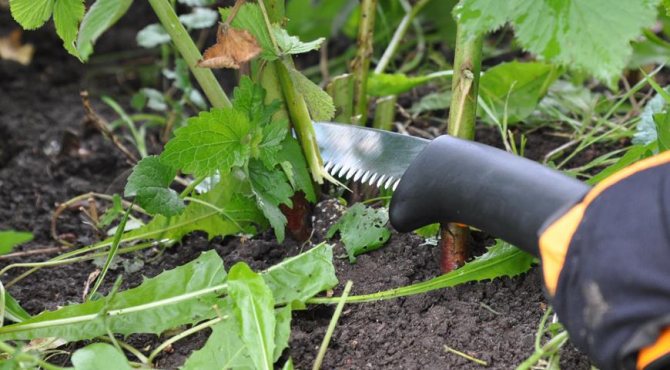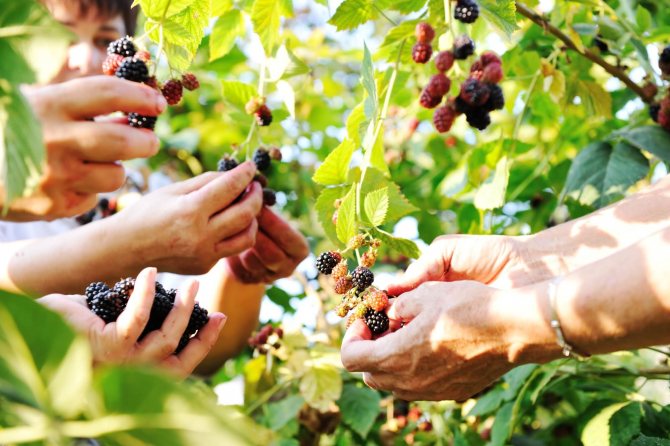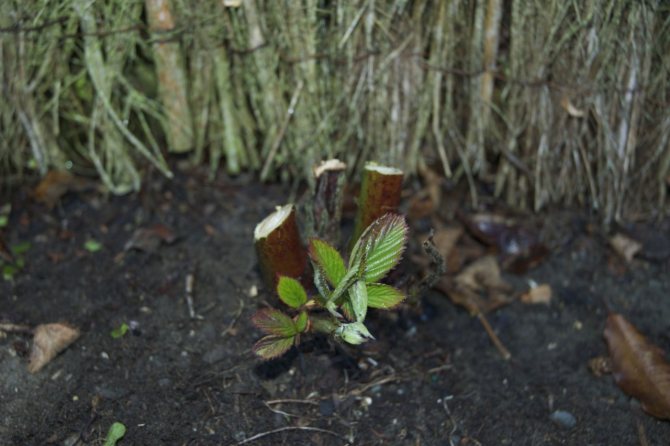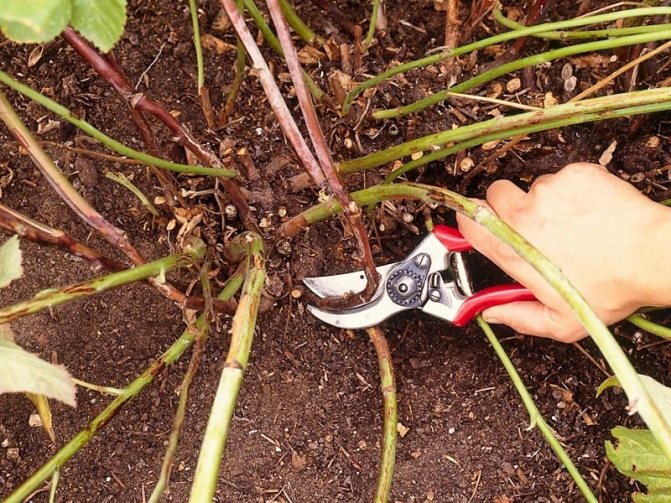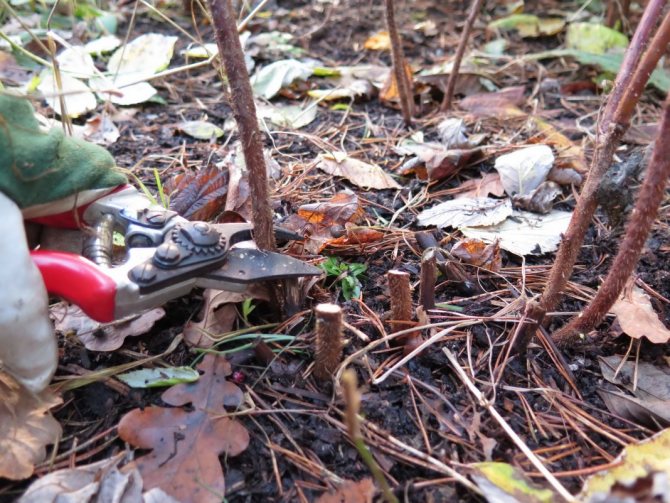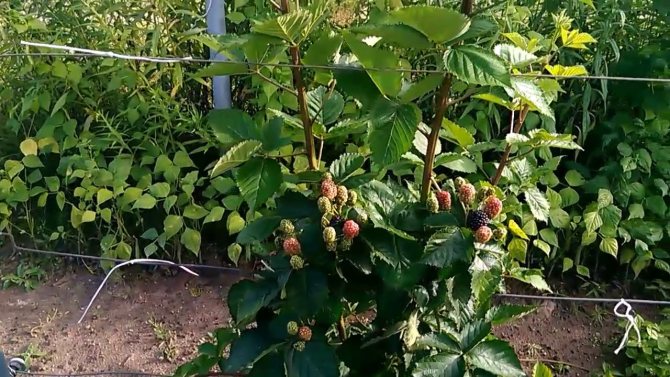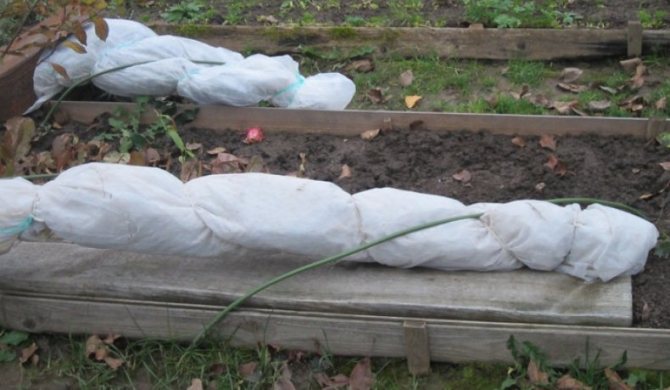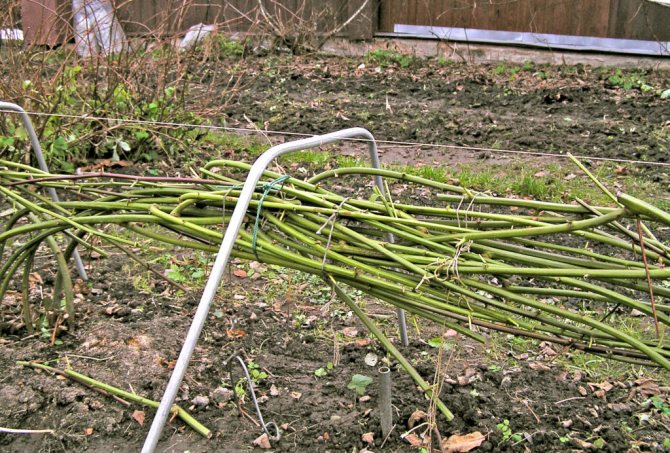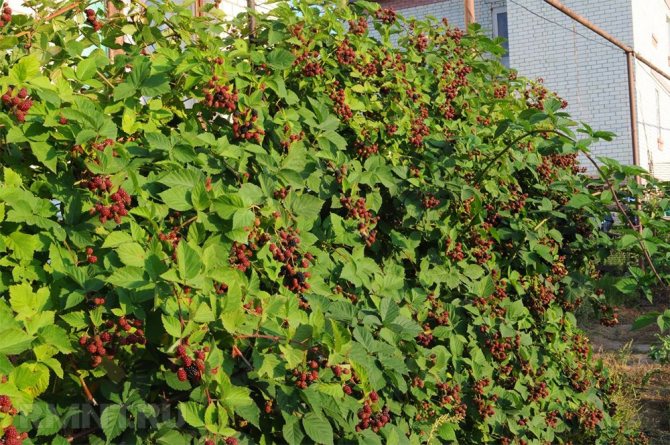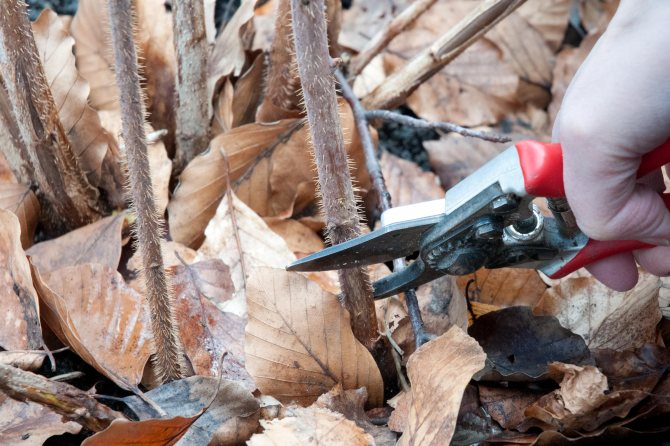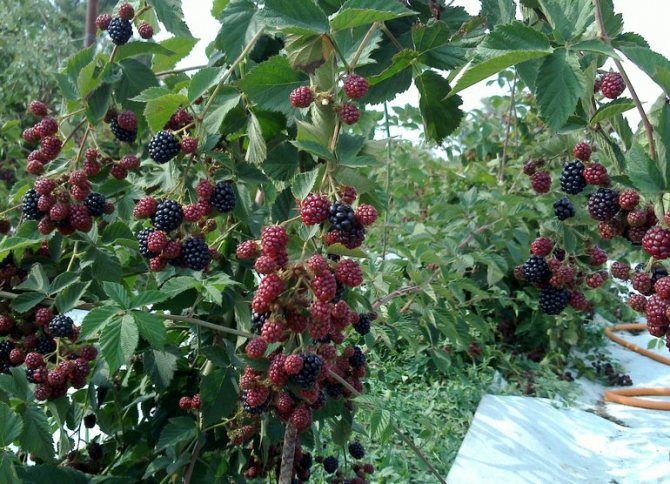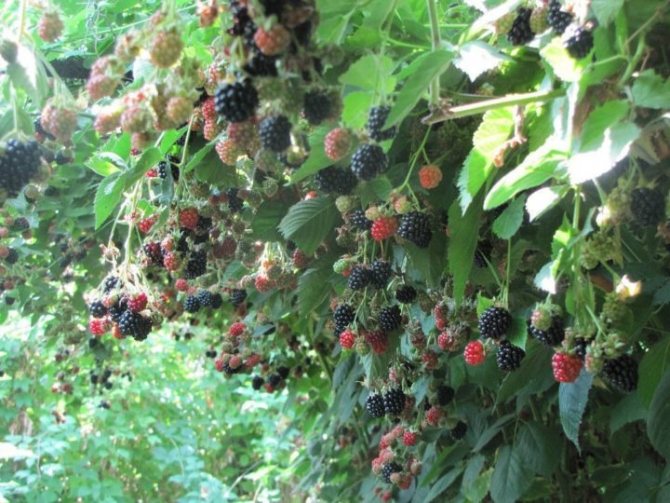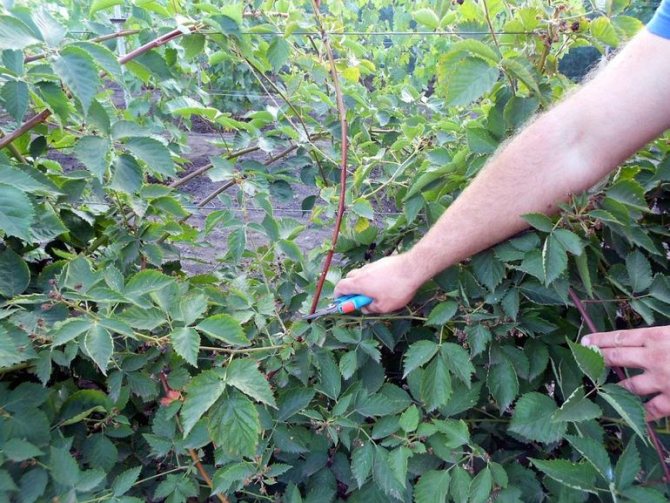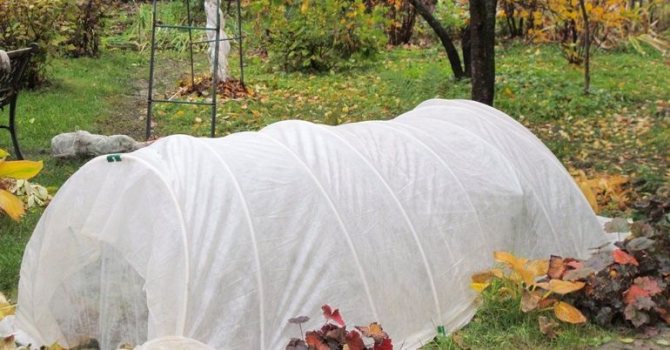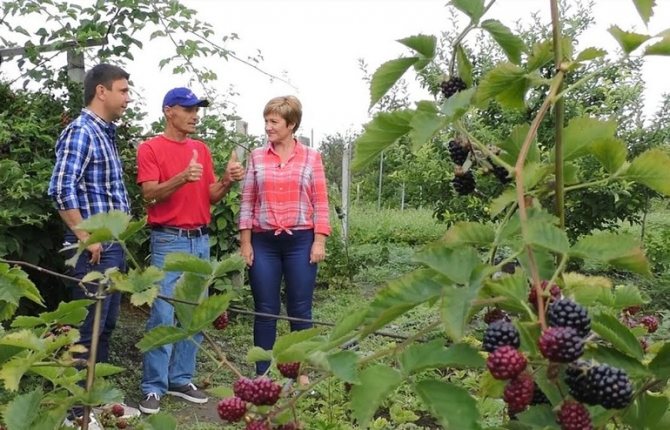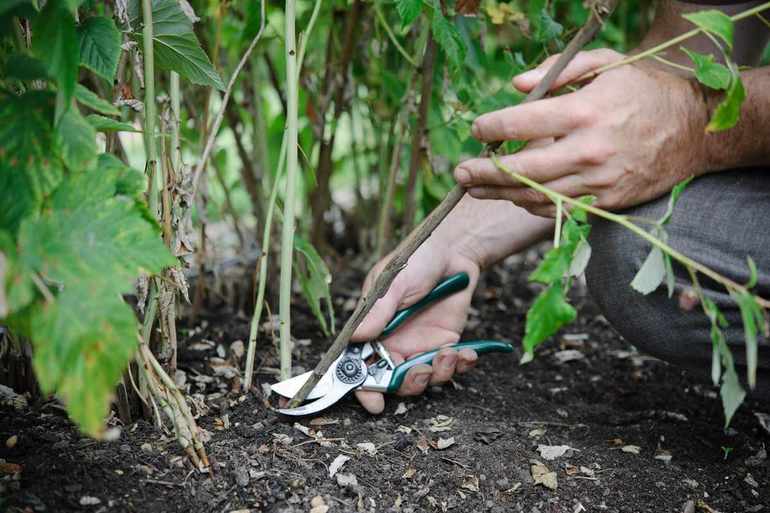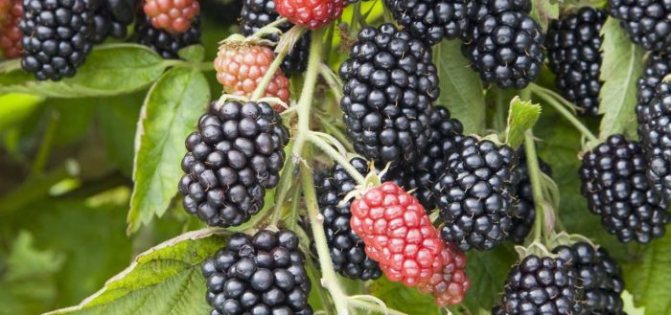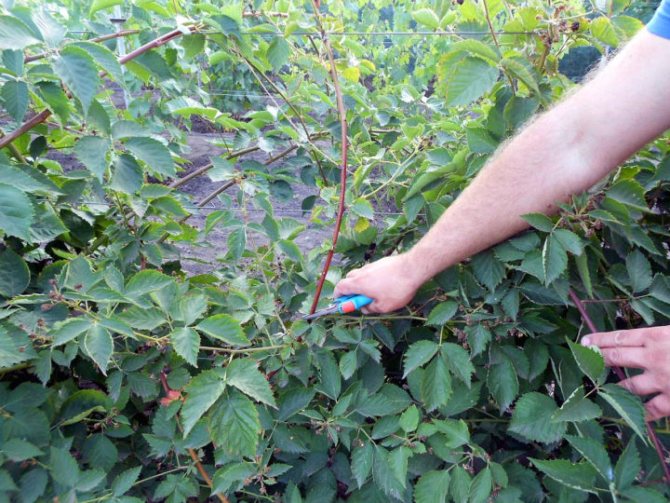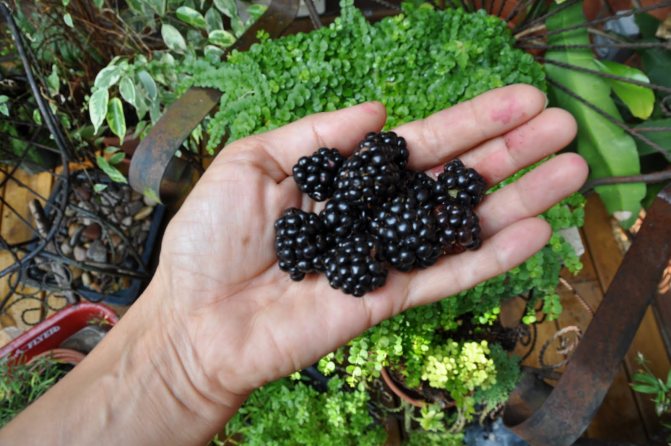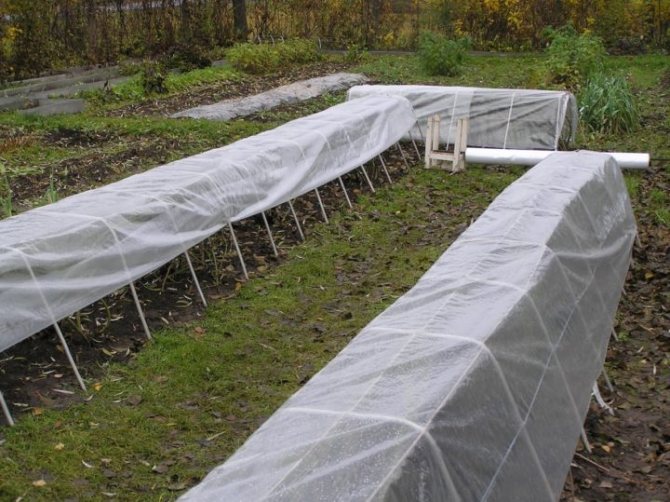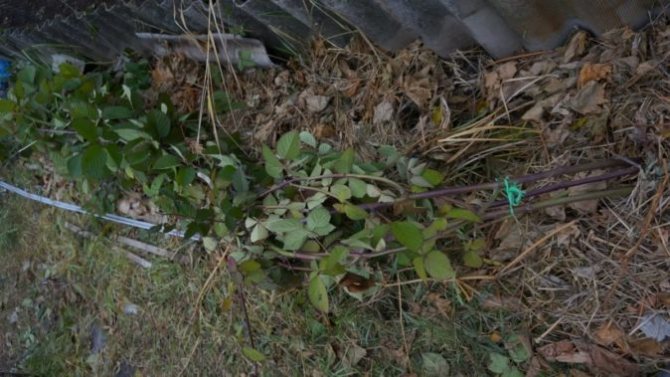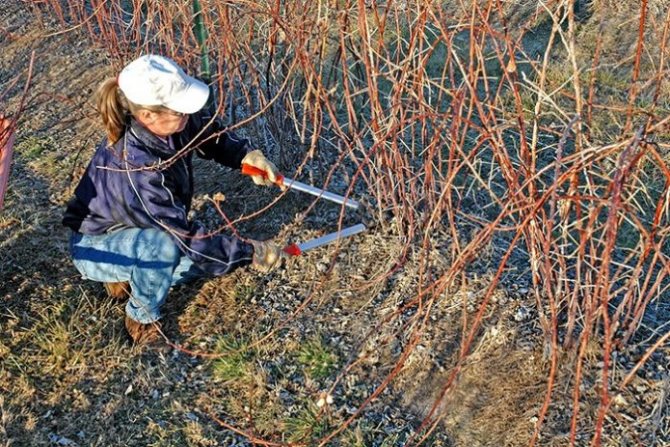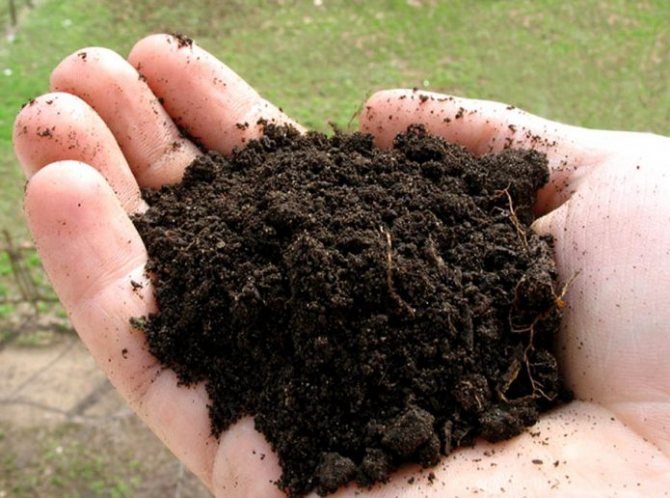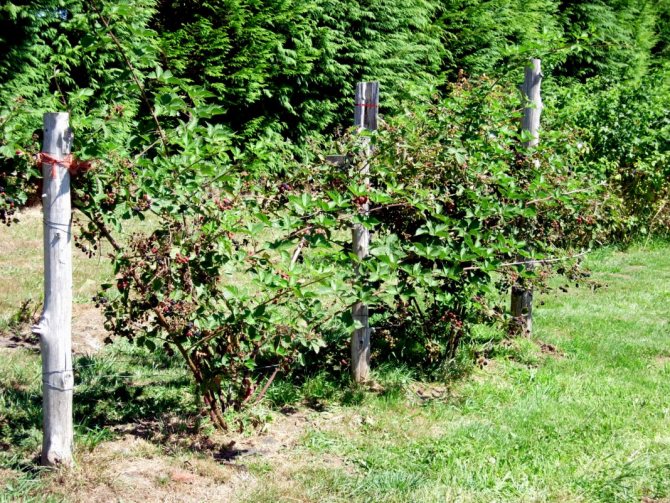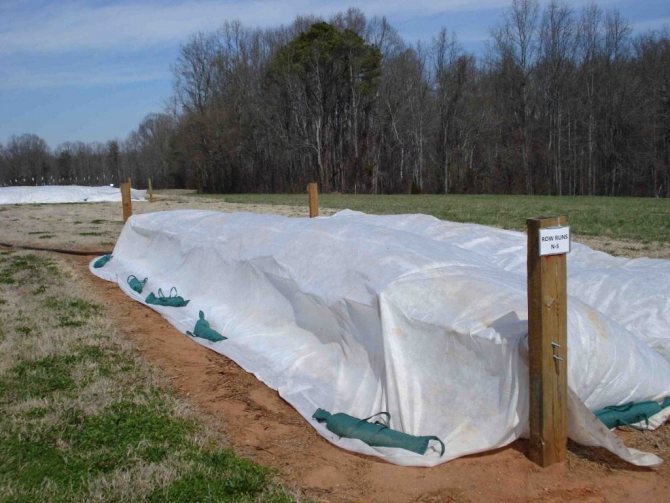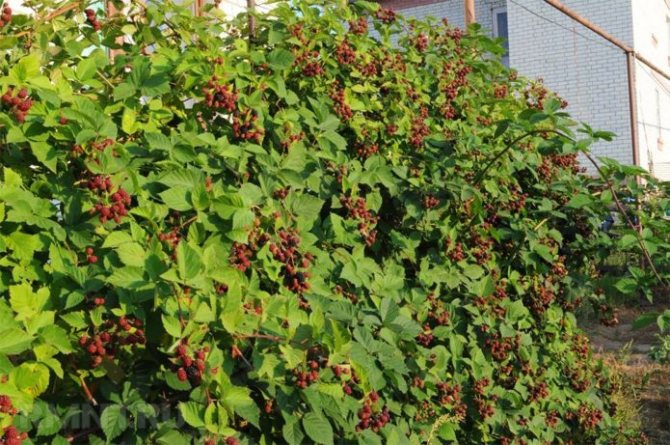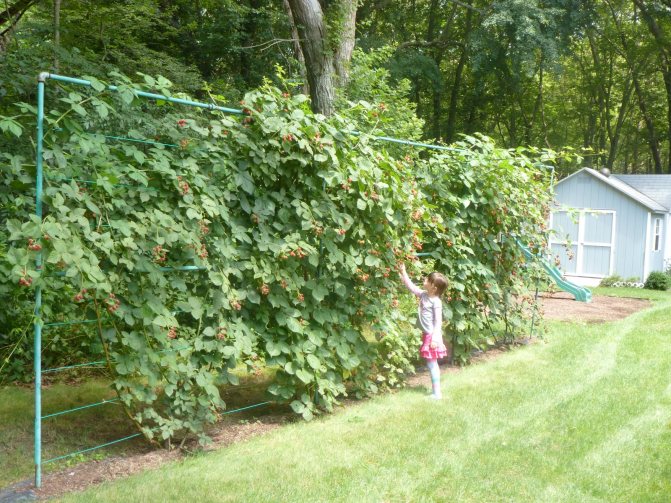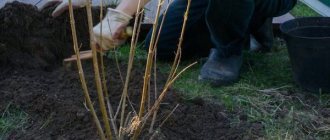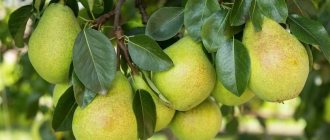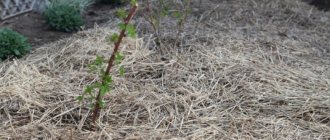Blackberries are similar to raspberries, only their fruits turn red at first, and then become a coal-black color. They have, it seems to me, a more interesting taste than raspberries, but the seeds are felt on the teeth much more noticeably.
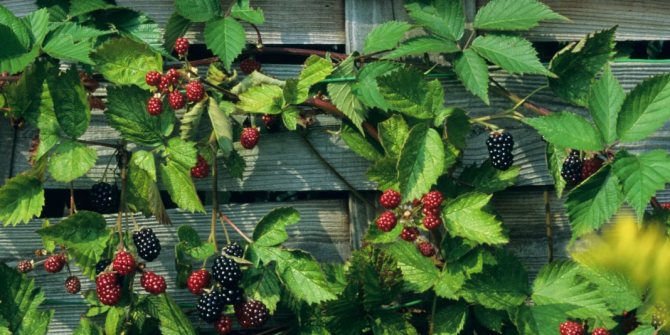
Autumn care for blackberries. <>
Thanks to the work of breeders, obtaining varieties completely devoid of thorns, as well as travelers and tourists who brought new foreign varieties with high quality fruits to our continent, it is gaining more and more popularity and more and more often it can be found in garden plots, but it works well blackberries, as a rule, exclusively when grown on a trellis, which must be installed in the second year after they are planted on the site. The trellis can be placed primitive, and if you have a dozen varieties of blackberries on your site, then plant them with a distance of two meters between the rows so that they do not interfere with each other. Drive in ordinary metal pipes with a diameter of 12-15 cm along the edges of the rows, drill holes in them and stretch a strong wire through them. From the second year, you can hang blackberry shoots on it, securing them with either wire or twine. All summer you will harvest, and when autumn comes you will think: what to do next!
Do not worry: before you remove the blackberry from the supports and lay it on a bed of soft foliage or wrap it up with it (and this should be done everywhere north of the city of Oryol), it is necessary to carry out sanitary pruning and feed it, combining it with water-charging irrigation.
Meet the blackberry


Wild blackberry
Wild blackberry has been known to man for a long time, and even today it is often found in forests, ravines, on the slopes of mountains in a temperate climatic zone. But they began to cultivate the berry only from the beginning of the 19th century. The primacy in this matter belongs to American gardeners. No wonder blackberries are grown in the USA on an industrial scale. For Europeans, the berry is still a novelty, but every year the interest in it is growing more and more. In Russia, I.V. Michurin, a famous gardener-geneticist, was engaged in the selection of blackberries. He bred varieties more suitable for local conditions than those brought from distant America.
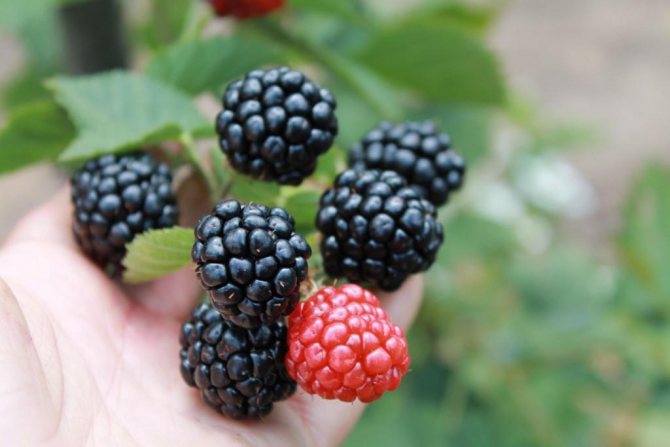

Blackberry Thornfree
It is believed that the name of the berry is related to the cute thorny animal. Blackberries are a hedgehog berry. And nothing surprising: the stems and branches of the bush are covered with thorns. For a long time this situation could not suit gardeners, and in the middle of the 20th century, American breeders bred the first bushes without thorns. Today, the best varieties that allow picking berries without fear of pricking are Thornfree, Chief Joseph, Loch Ness, Helen and others.
Blackberry is a shrub belonging to the genus Rubus (Pink). Blackberries are dark purple or black, although there are also red-fruited varieties. It differs from its forest cousin raspberry in high yield and undemanding soil conditions. Berries, the weight of which can vary from 5 to 20 g, begin to ripen from mid-July, and fruiting ends in some species in mid-autumn. Blackberries hardly suffer from the invasion of insect pests and are not susceptible to various diseases. But for the winter, in order to avoid freezing, it is better to cover the plant with suitable material.
Blackberries, like raspberries, are used to treat problems of the gastrointestinal tract, nervous system, high fever and cough. The decoction of the roots is a good diuretic, and the juice has a rejuvenating effect on the skin.
On the branches of blackberries, you can see berries of varying degrees of ripeness: from very green and unripe to red, ripening and black, ready to eat. Such extended fruiting allows you to feast on the berry for a long time, almost until frost. Part of the crop planted too late in the fall may not have time to ripen. This also happens on remontant varieties, where autumn berries appear on one-year-old shoots.
Pre-winter watering and feeding


The whole season, caring for an adult bush involves watering about three times. Such a small volume of water is due to the structure of the root system. In blackberries, it goes far into the depths of the earth, where it is able to independently extract moisture. With minimal watering, the bush can live in one place for up to 10 years. Surface moisture is partially retained by mulch.
Obligatory water-charging watering of the plant is needed in the fall before winter before the onset of frost. Simultaneously with the water, top dressing is applied under the bush. For the winter, the plant needs potassium and phosphorus. Fertilizer should not contain chlorine. You can dig compost with the addition of superphosphate under each bush before watering.
Types of blackberries
There are different types of blackberries. Depending on the type of growth and the method of reproduction, it can be divided into three large groups.
Kumanik or bushy blackberry
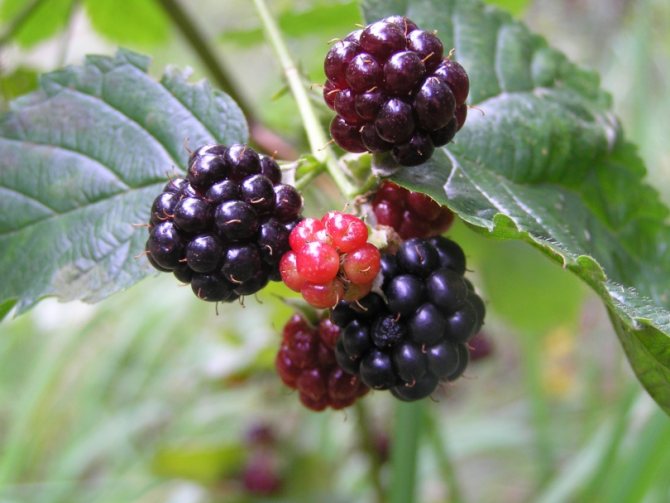

Blackberry fruit
These varieties, similar to raspberries, are distinguished by erect stems, the height of which can reach 2.5 m.Over time, the shoots begin to slope in an arc, therefore kumanik is grown on trellises, fixing the lashes according to the fan pattern. The stems have many thorns, the fruits look like small black cylinders with shine. Erect blackberry species are frost-resistant, but many gardeners prefer not to risk it, and cover the bushes for the winter. The plant propagates, like raspberries, by offspring growing from the root. Among the popular varieties of blackberries, Apache, Ouachita, Agavam, Ruben stand out.
Rosyana or climbing blackberry


Dewberry blackberry
It is also called creeping blackberry. The plant resembles its wild relatives and has long creeping stems-lashes, growing up to 5 m. But for convenience, they prefer to grow it on supports. There are varieties with and without thorns. In the European part of Russia and Siberia, winter-hardy varieties of dewweed are planted, but cultivated plants require mandatory shelter, since they can die in frosts. At the same time, climbing blackberries are not capricious and calmly tolerate small droughts, and can bear fruit in partial shade.
The fruits are round in shape and blue-violet in color with a delicate matte bloom. Creeping blackberry bushes produce more berries than erect varieties, and they differ in taste for the better. The creeping blackberry propagates by seeds and rooting of the tops of one-year-old shoots. Popular varieties: Texas, Columbia Star, Lucretia, Oregon Thornless.
Repairing blackberry


Repaired blackberry fruits
More recently, breeders have bred remontant varieties that give two harvests per season. In an annual berry, young shoots bring their first harvest in the fall. Next year, on the same shoots, the fruits will ripen in the summer in mid-June, and the young shoots will bear berries in September. Such varieties grow in the form of strong bushes with straight shoots. Unlike climbing species, the remontant berry does not require a tie to the supports. And during preparation for winter, it is not necessary to cover it. Repaired varieties: Prime Arc, Ruben, Amara, Black Magic.
Experienced gardeners recommend growing all types of blackberries on trellis supports. This method not only makes it easier to care for the plant, but also doubles the yield.
Useful Tips
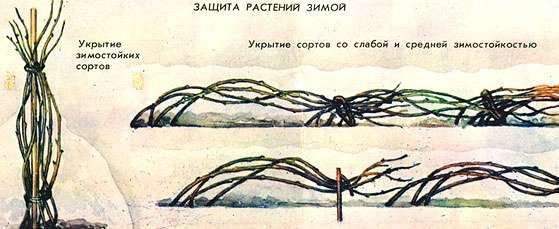

In order to understand as much as possible the nuances of preparing blackberries for winter, you can read a few useful tips from summer residents who have been growing blackberries for many years.
- With long thaws, which, depending on the region, can take place in February-March, it is necessary to arrange airing of the blackberries. Otherwise, the shoots will be weeded out and affected by rot.
- It is recommended to use white agrofiber for shelter, which will not get very hot in the scorching March sun.
- In order to prevent the formation of a layer of infusion on the snow cover during alternating thaws and cold snaps, crossed stakes are driven in near the blackberry in the fall.
Knowing some basic rules, you can organize the best conditions for wintering a blackberry plot.


Not all Russian summer residents undertake the cultivation of blackberries - it is too much trouble with wrapping it up for the winter. This circumstance is not too frightening: if you know all the nuances of organizing a winter shelter, you can harvest excellent harvests of useful black berries every year.
Why do you need autumn pruning of blackberries


Autumn Blackberry Pruning
There is a proverb: "Blackberries along the fence will not let even a thief into the garden." And not only him, but also the owners, if you do not prune the shrub in time. True, breeders have also bred the thornless blackberry. But many people prefer the classic berry.
Blackberry shoots live for two years, then they grow old and barely bear fruit. The first year is the growth and laying of fruit buds. And only next summer, flowers appear on thin annual branches from the buds, followed by berries. The exception was remontant varieties, in which both one-year and two-year shoots bear fruit. Two-year-old stems are easy to distinguish, the bark on them is brown or red, while the young growth is mostly green.
But the stalk in the third year is already unnecessary ballast, but it will still need food. When pruning, gardeners remove old shoots so that the root system directs all its forces to the formation, development of young shoots and fruit setting. The abandoned and thickened bushes, although they continue to bear fruit, the berries on them run wild and shrink.
Other benefits of pruning blackberries in the fall:
- Thinning the bush helps the plant get more sunlight and warmth. As a result: berries ripen faster and acquire good taste. Sometimes, with a lack of lighting, young shoots are too stretched up. Then you have to partially remove them and cut the rest so that the green mass does not obscure the rest of the bush. A plant that is too thickened, on which pruning has not been done, is more weakened and susceptible to various fungal diseases.
- Trimming the tops of the shoots helps to increase the number of fruit branches. Such a stem and yield will give more. This is also convenient for picking berries when they grow concentrated on the shoots.
- The thickened blackberries will be difficult to cover for the winter. Lignified shoots will require a lot of covering material, and bushy forms grow to a height of up to 2.5 m, whips - up to 5 m,. As a result, part of the blackberry will freeze out in frost.
- Pruning helps to create the correct shape of the plant. For example, to get a harmonious bush, it is formed in the form of a fan, rope or weaving. In this case, fruiting shoots are separated from young ones. The stems are directed in the right direction, cutting off the tops of the young growth and removing the old stems.
- Removing broken and diseased branches prevents the shrub from becoming infected with various diseases.
Pruning and covering some varieties of blackberries for the winter is the final work of this growing season. Not only the future appearance of the plant depends on the correct haircut, but also the harvest that will grow on it.
Loosening
There is no unequivocal answer about the benefits of this procedure. It is important to remember that the roots of this plant are located close to the soil surface, so loosening stimulates the growth of root shoots. It all depends on the variety and the purpose of growing. If the task is to obtain planting material, and the variety is not provoked to the formation of side shoots, then it is still worthwhile to loosen the planting.
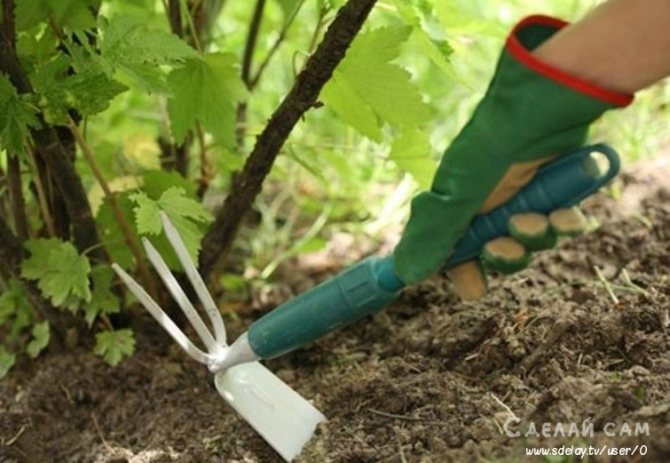

Timing of pruning blackberries
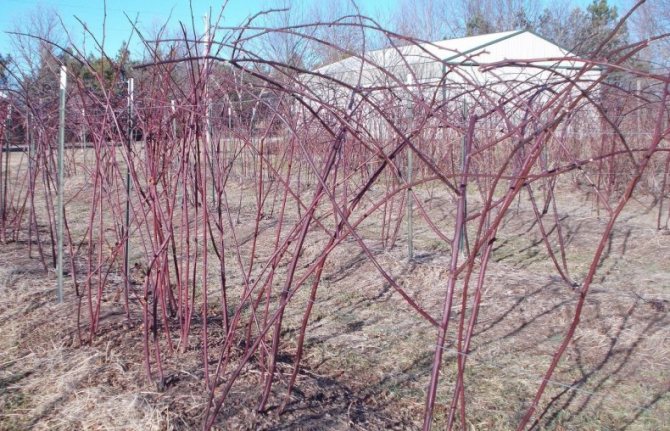

Pruned blackberry bushes
Traditionally, blackberry pruning is done in the spring and fall. Some gardeners in the spring "haircut" remove the frozen parts of the bush and shorten the young shoots, while in the fall it remains to cut off the two-year-old branches that have borne fruit.
Most fans of digging in the beds prefer to carry out the main actions for pruning blackberries just before the onset of cold weather. So the plant, freed from the harvest and the burden of old, diseased shoots, part of the young growth, will be able to rest during the winter and will bloom with renewed vigor in the spring. And after the snow melts, it remains only to slightly correct the plant by removing the frozen branches.
It is quite difficult to name a specific day or even a week for pruning blackberries. Many start pruning immediately after the end of fruiting, some later. The following factors also affect the timing of pruning:
- types and varieties of blackberries, there are different ripening periods;
- placement of a semi-shrub, on a site with what kind of soil, relief it grows;
- features of the climate of the region;
- cultivation methods, agricultural technology.
Work can be carried out from the end of August to almost November. But you shouldn't delay with them either. In cold regions, for example, the Leningrad region, it is advisable to put the shrub in order 3-4 weeks before the real cold weather.
Blackberry care in autumn
Autumn care for this fruit-berry crop is very important, since it is the neat and prepared blackberry bushes that tolerate the winter period well under cover. The main activities that need to be done in the fall are pruning, feeding and preventive treatment against pests and diseases.
Pruning


Blackberry pruning is carried out twice a season: in spring and autumn. The most suitable period for the main formation and cleaning of the shrub is autumn, and in the spring they only correct their results until the buds awaken.
First of all, sanitary pruning is carried out in the fall. It consists in removing all dry, broken, damaged and deformed shoots. They must be cut into a ring, that is, without leaving any stumps. Hemp is a cozy place for wintering pests and pathogens of various diseases. Here, they get rid of all the old (fruiting in the season) branches, which will no longer yield a harvest next year.
Further, at the bush, the number of remaining shoots is normalized (from 4 to 11, depending on the variety), only the strongest, thickest and strongest are chosen. All the rest are cut out. The tops of the remaining branches are shortened, which do not have time to ripen by the time of cold weather, by 7 ... 10 cm.
Thus, the autumn pruning of the blackberry bush will help bring it into a presentable decorative look, increase the yield in the next season, increase winter hardiness and protect it from the effects of overwintered pests.
How to trim and prepare blackberries for winter: video
Top dressing


There is one interesting feature that you need to know before fertilizing a blackberry bush: first, it is abundantly watered, after which any top dressing is applied. In the autumn period, blackberries respond well to the introduction of both organic matter and mineral fertilizers.
Under one bush add 6 kg of humus (can be replaced with compost), 100 g of superphosphate and 30 ... 40 g of any potassium fertilizer, which does not include chlorine, for example, potassium sulfate, potassium magnesium. This mixture is carefully sealed with a pitchfork into the blackberry periostemal circle to a depth of about 10 cm.
Treatment against pests and diseases
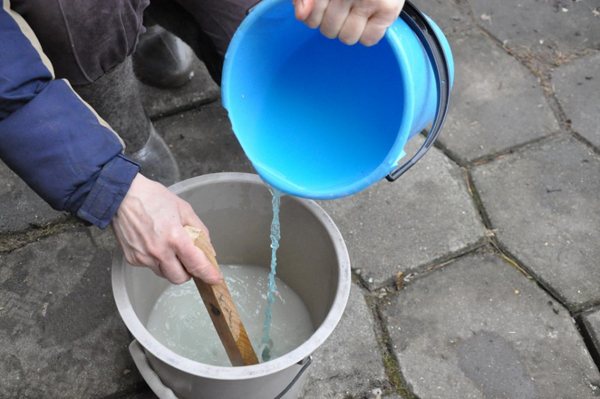

As a prevention of the appearance of fungal diseases for blackberries, a 1% solution of Bordeaux liquid is used. It is distributed over the shoots and the surface of the periosteal circle only after the foliage has fallen off. In order to destroy most of the pests of blackberries, it is enough to dig up the near-stem circle of the bush. Finding themselves without shelter, the pests die.
If during the season severe damage by pests or fungi was noticed, more drastic measures must be taken - to treat the plantings of blackberries with insecticide preparations or strong fungicides. Processing is carried out after harvesting and removing damaged parts.
General principles of pruning blackberries
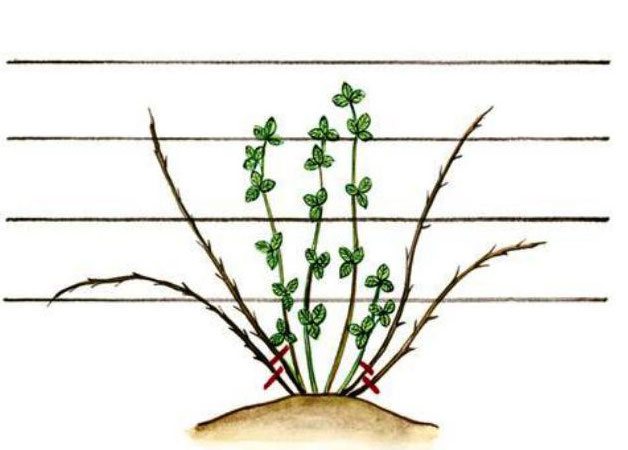

Garden blackberry pruning scheme
Growing blackberries correctly is troublesome. Moreover, you will have to regularly prune the bushes. But tasty and aromatic berries with a lot of useful properties are worth it.
The first pruning is done during planting. The root bud of the seedlings is deepened by 3-4 cm, and the stems are cut at a height of 25-40 cm from the ground. You can leave a few leaves or buds on each branch. A plant can produce about 10 shoots per year. In the first autumn, the branches of blackberries are shortened to 1.5-1.8 m. In creeping varieties, the shoots are cut off at the bend after one of the buds.
In the following years, pruning of different types of blackberries is done according to the general scheme:
- In autumn, after fruiting, old two-year-old lashes are removed. They are cut at ground level. You don't need to leave the stumps.
- Young one-year-old shoots are examined and 8-10 of the largest and strongest ones are selected. This will be the groundwork for next spring, they will first give flowers, and then berries. The rest of the peers are removed at the root. Blackberries can produce a lot of young growth. If you regret and do not cut off the excess, no cultivated plant will work.
- The abandoned annual stems are shortened from above by a quarter. It is advisable to treat the cuts with garden varnish or mastic, this will prevent the penetration of infections. Such a "shearing" of young stock will stimulate a richer harvest for the next year.
- A sanitary inspection of the bush is carried out next spring. Frozen shoots are removed. They usually have a very deplorable appearance - black, dry, brittle. Such stems are cut at the root.
Novice gardeners need to know that you can't take a blackberry with your bare hands. Therefore, when starting to trim, it is worthwhile to be well equipped and armed. Tight clothing and gloves will work, and pruning shears, a hacksaw, or garden shears will work for trimming bushes.
Preparing lashes for shelter
This stage is best carried out before the onset of stable frosts, in warm sunny weather, since in the cold the lashes become fragile and inelastic. You need to start mulching the trunk circles. After that, the stems of the shrub are collected in non-tight bundles and tied (with the help of twine or other improvised means), then the resulting structures are neatly bent to the soil and pinned using wooden hooks or electrodes. Although there is an opinion that blackberries feel great in winter in a shelter with green leaves and will not shrink, but it is still better to get rid of excessively lush foliage, especially since there will still be little use from it in the spring.
Blackberry formation
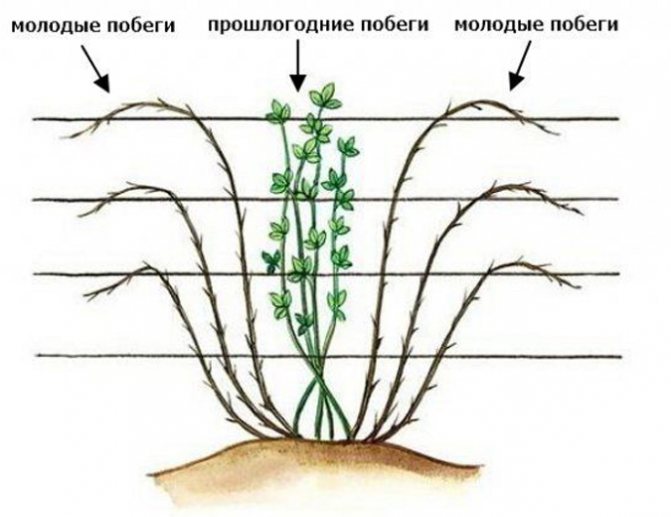

Scheme of the formation of a blackberry bush
The formation of a blackberry bush makes it easier for the novice gardener to care for the plant. How the formation of an upright bush is carried out, we tell you step by step. In the spring, the surviving shoots are tied to horizontal supports. Old whips are placed in the center, and young ones on the sides. They are fixed obliquely.
In the fall, the entire two-year-old central part is cut to the ground. And among the young, a dozen strong and healthy ones are left, they are shortened by ¼ from above. Since in spring these stems were launched horizontally, it is easy to remove them from the support, press them to the ground and cover them for the winter.In the spring of next year, two-year-old stems that have already wintered are fixed in the center, and the young shoots that have appeared are again on the sides.
The formation of a creeping bush is also performed step by step. Such a plant has more flexible long branches. All the lashes are again divided into two parts. Those who survived the winter head in one direction. For convenience, in the spring they are wound on a trellis like a thread on a spool. New shoots are wound in the same way, but in the other direction. Excess stems are removed. In autumn, old shoots from one half of the bush are completely removed, and the one-year-old young growth is untied, several of the strongest are selected (the rest are cut off) and they are laid for the winter under a shelter. The next year, these branches are released and tied up on one side, and on the other, the young growth is fixed. Caring for the studless blackberry is even easier. The absence of thorns allows you to quickly fix or, conversely, remove the lashes from the supports.
Do I need to cover frost-resistant varieties
Blackberry varieties are divided into frost-resistant and frost-resistant (need shelter for the winter). The first species tolerates winter frosts well, does not die at a temperature of -20 ° C. Overwintering without shelter is likely to negatively affect the condition of the bush. If the gardener is interested in a rich harvest, he even covers frost-resistant varieties.
REFERENCE. It is believed that in the southern regions, with mild winters, sheltering blackberry bushes has a positive effect on yields.
Spring frosts can negatively affect bushes if they open early. Basically, they do not affect the health of the plant, if the ground is warmed up enough and in this case it is not necessary to cover the blackberry, since the plant blooms rather late.
What activities are carried out after pruning blackberries


Fertilizing blackberries with humus
Autumn pruning is accompanied by a number of actions that are aimed at preparing the plant for a long winter. After leaf fall and trimming, all unnecessary organic material is raked up and burned. Insect pests can hide in old foliage and there are foci of infection.
In preparation for winter, autumn feeding of the plant is also included. You can sprinkle phosphorus-potassium fertilizer around the bush at the rate of 20 g per square meter. Or spread compost and manure nearby in a layer up to 10 cm thick. Nitrogen substances should not be added, fertilizer will stimulate the growth of young shoots, which is unacceptable before cold weather.
Only a plant with mature or mature stems will be able to withstand the winter well. The green growth will freeze, and during thaws it will start to rot and become a source of infection for the entire bush. After applying the fertilizer, it is worth loosening the soil so that the fertilizing is evenly distributed under the bush.
If autumn does not indulge in rains and the days are dry and sunny, moisture-charging watering will help the root prepare for the cold weather. Such an event is held at the end of September and October, when the upper part of the plant has borne fruit, but the root system begins to actively grow. Then it will be easier for the plant to winter. In addition, watering keeps the soil warm and rescues the roots from dry winter. For each plant, at least 20 liters of water will be enough. In order for the roots to receive the right amount of liquid, a hose is left next to the bush and water is supplied with a slight pressure. For a successful procedure, a low earthen side is formed around the bushes. After watering, young lashes, plenty of water, are carefully fixed on the soil.


Shelter blackberries for the winter
Whether or not to shelter blackberries for the winter depends on the specific variety and location. There are species that do not require frost protection. They winter well under the snow. But some varieties, especially specially bred thornless berries, require protection from the cold even in the southern regions. In the northern regions, for example, in the Leningrad region, varietal blackberries without shelter can die.To prevent this from happening, the lashes are removed from the supports, laid on a bedding (mulch). Here, among the shoots, a remedy for rodents is also left.
The whole mass of branches is covered with lutrasil or spunbond. The edges of the material are firmly fixed to the ground so that sharp gusts of wind cannot blow off the shelter. Dry branches of reeds or spruce branches are thrown onto arcs set above the bush. Again, a nonwoven fabric is thrown over the top. This type of shelter allows air to circulate, which acts as an insulating role between the layers.
Garden blackberry, preparation for winter. Various options for covering material
What materials can be used to hide a blackberry? In this case, the choice is quite rich: you can use improvised means, the remnants of building materials or special covering materials. Although a combination of different materials is the best option, this will provide more protection for your plants.
Improvised means


First of all, one can use land - this is the most affordable material that guarantees good cover. Problems can arise in the spring, when you have to get thorny bushes out of the ground, in this case, as a safety measure, you must use thick gloves or mittens so as not to injure your hands.
Another free and readily available shelter material is snow, but there are also some disadvantages. With temperature changes, the snow melts and freezes again, covering the covered plant with an ice crust, and this is extremely undesirable and rather dangerous.
Another type of material that is suitable for hiding blackberries is hay. It is necessary to prepare such material throughout the summer, collecting and drying vegetable tops, weeds or corn leaves (tough and almost waterproof - they are one of the best covering materials).
It is important that all the grass is free from signs of disease or harmful insects, as well as free seeds that can ripen and spread weeds. It should also be borne in mind that in such a warm and easily passable shelter, mice can settle, which can ruin the blackberry shoots. Therefore, when using hay or straw, you must take care of poisonous baits against rodents in advance.
Another great covering material is spruce branches. The branches of a pine tree or a Christmas tree will not only provide the plant with warmth, but also scare away mice and harmful insects with their rather strong smell. If we add to this the fact that they perfectly pass moisture and air, then we can conclude that spruce branches are the best material for sheltering any plants.
For sheltering plants for the winter, they are often used burlap. But it is recommended to do this in combination with other materials, since burlap itself, although a breathable material, is not warm enough.
Sawdust it is not recommended to use it for shelter, since this material absorbs water well, turning into a wooden block of ice in frost, which ultimately will not lead to the protection of the plant, but to its death.
Remains of building materials
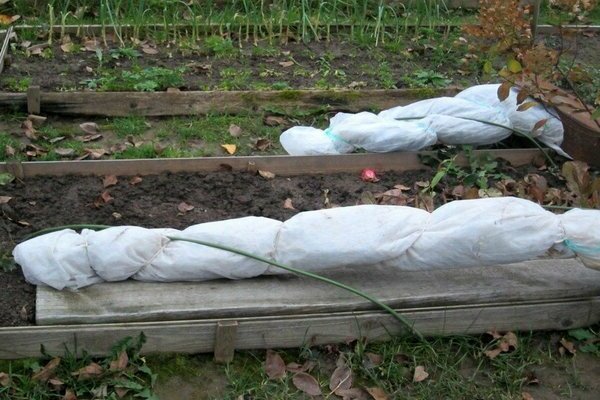

Often, leftovers are used to shelter plants linoleum or roofing material. These materials protect plants well from frost, it is not difficult to build a shelter out of them, but in severe frosts they become rather fragile and most likely it will not work to reuse them.
Felt or sintepon can be used only if you are sure of stable frosty weather throughout the winter, since during a thaw such material will become saturated with moisture and pose a danger to the blackberry bushes covered by it.
Before the day of winter shelter, dense plastic wrap, but now gardeners are increasingly abandoning this material, since with frequent temperature changes in winter, the covered plants do not breathe at all and die under a layer of film.
Special covering materials


Now a large number of nonwovens are produced, otherwise called geotextiles: lutrasil, spandbond, agrotex. All of them perfectly retain heat, while allowing both moisture and air to pass through, and therefore they can be used at any temperature, without fear of condensation and overheating of plants during thaw and icing when the air temperature drops.
In addition to geotextiles, you can use foam, which also provides warmth, but, as with hay, you have to worry about rodents. Materials such as polystyrene and geotextiles can be used for more than one year, and with their help a rather large area of the garden can be protected, the only problem is that they are quite expensive.
Typical mistakes during work
Often, novice gardeners make mistakes when pruning, thereby harming the plant. This subsequently negatively affects the productivity of the bush and can lead to its freezing in winter.
Common mistakes to avoid:
- Pruning should not be carried out after the onset of frost.
- Gentle removal of young pagons has the opposite effect. In this case, the plant is not able to provide food for all branches, as a result of which the berries become smaller.
- Failure to comply with the frequency of the procedure. Pruning should be done every fall, otherwise the bushes will thicken, and the yield and their immunity will decrease.
- The tool for work must be disinfected in advance so as not to infect an infection.
- All damaged and weakened shoots must be removed without regret, otherwise the plant will spend energy not on fruiting, but on their restoration.
Pruning scheme for beginners
To get a positive result, a healthy plant and a decent harvest, it is worth using the scheme. Let's dwell on the step-by-step order of work.
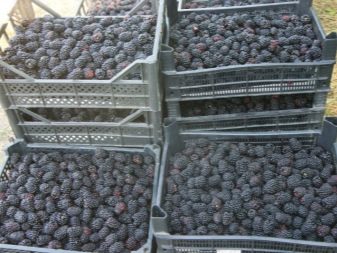

When the pruning process ends, you should get rid of the pruned branches. It is also necessary to carefully rake the leaves near the plant. This garbage must be put away from the crop planting and burned. This allows the site to look attractive and aesthetically pleasing, and also relieves the gardener of a variety of problems associated with pests and diseases. So that the moisture does not evaporate quickly, and the soil freezes less, the soil around the plant can be well sprinkled with sawdust or peat.


Regional features of care
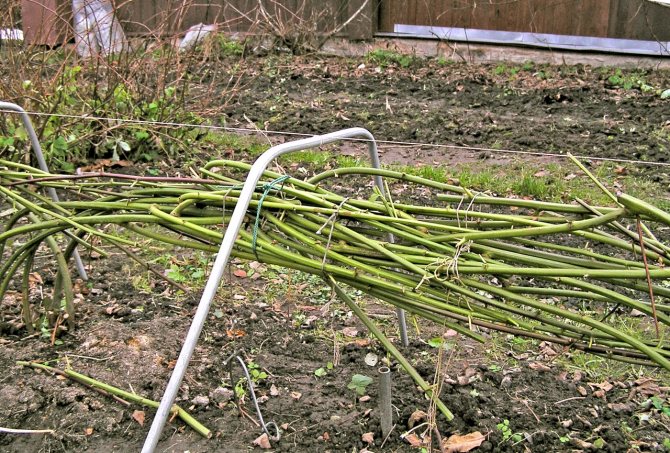

Winter-hardy varieties can withstand frosts down to -20 degrees, medium-hardy - up to -17
Climate differences in Russian regions force gardeners, who appreciated the quality of blackberries, to use special methods of sheltering shrubs from frost. If in the Crimea and Krasnodar Territory, before winter, they only prune and remove two-year-old shoots, and then leave the bush without even removing its branches from the trellises, then in the middle lane they certainly use shelters made of various materials.
In the Urals and Siberia, to protect the blackberries from frost, insulation and a double layer of agrofibre are laid on the branches.
In regions where winters are frosty and with little snow, gardeners protect blackberries even during planting by planting young plants in trenches dug to a depth of about 30 cm. Before the onset of cold weather, shoots pre-wrapped in several layers of covering material are laid at the bottom of the trench. Some gardeners build a box of boards on top of it and cover it with foil.
In most Russian regions, gardeners grow frost-resistant blackberry varieties that can withstand cold temperatures of more than 20 ° C. However, young shoots are sensitive to low temperatures. If they freeze, they will no longer bear fruit in the summer. Therefore, to ensure the harvest of berries, even frost-resistant varieties of blackberries must be protected from the cold.
Rules and features of the formation of bushes
Before winter, it is worth forming the correct shape of the bush. The erect form is more resistant to frost than the creeping one. But at the same time, it is more brittle and less flexible. Therefore, erect varieties are recommended to "dissolve" like a fan, and creeping ones - to be divided into 2 parts: vegetative and fruiting.
Erect form
To form a fan, you must:
Creeping form
The creeping form is more flexible, but less winter-hardy. To form it, you need:
- Wind the branches that have survived the winter on the trellis. Let them go to the right relative to the growth point.
- Wind all young growth on the left hand from the same point.
- In the fall, remove all excess shoots and remove the plant from the trellis. Expand the vine on the ground.
- Cut off all branches except 8-10 healthy ones that have not yet borne fruit.
- Roll up the whips and put them in trenches for storage during the wintering period. Additionally, cover the studless varieties with agrofibre and fix with arcs.
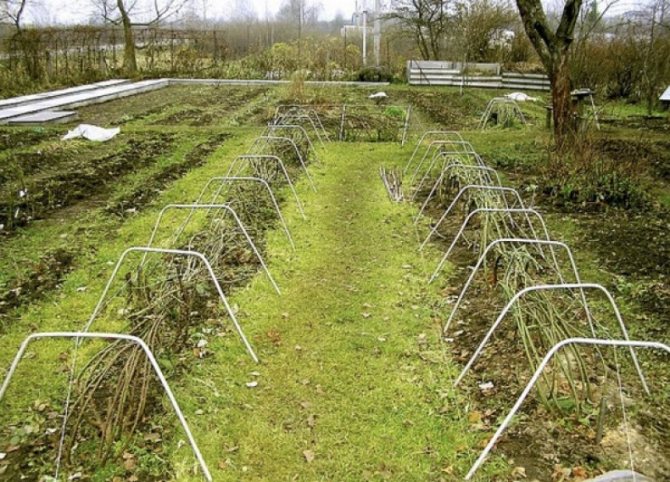

How to form a bush?
If you treat the formation of the crown carelessly and irresponsibly, the old and new branches will intertwine with each other so that during the pruning process the gardener will not be able to get to what should be removed. It can damage young shoots and destroy the plant. Therefore, you should not neglect this aspect of care.
To make the process of autumn pruning simpler and easier, it is important to create a special molding in advance. There are two types of plant: creeping and erect. How to carry out the operation depends on what kind of species the gardener encountered.


Erect
After the winter period, it is necessary to vertically raise the whips that survived on the trellis. They should be above the center of the plant. New, young lashes should be tied at the bottom of the trellis on both sides of the center of growth of the blackberry. This is necessary so that they develop parallel to the soil. This crown shape allows you to cut off excess areas in the fall. It will be necessary to cut off the entire central part under the root system, and leave only new shoots that will creep along the ground.
Over the summer, young lashes will form horizontal. You should choose the 8-10 most healthy ones, and remove the others. The branches that remain must be shortened by a quarter, then pressed to the ground and carefully covered until the beginning of March. At the end of February, the shoots rise vertically, and then they are given time to warm up and become more flexible.
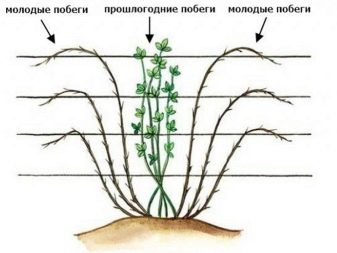

Creeping
It is rather difficult to form such bushes, since their lashes are too long and have very high flexibility. Many gardeners recommend leaving eight to ten strong new shoots in the spring. Such pruning will affect the economy of cultural forces and the preservation of necessary substances.
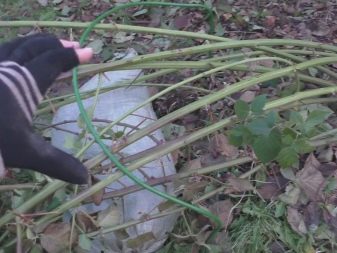

Specialist recommendations
Planting of blackberries is traditionally carried out in the spring. For plants, choose well-lit, moist areas without strong wind. It is important that the soil is prepared in advance. Blackberries cannot tolerate high limestone content.
Advice! Shoots of early and late varieties are used as planting material. This allows you to increase the period of fruiting.
The best place is considered to be a site with drained loam. Before planting, each hole is fertilized with manure, superphosphate and potassium. Fertilizers are taken in a ratio of 5-6 kg. Mullein, 150 grams of superphosphate and 50 grams of potash.
If a liquid composition is used for feeding, then experts recommend applying it not directly under the bush, but into the furrows at a distance of 30-40 centimeters. The types of fertilizers used are periodically changed. Mineral complexes alternate with organics. An excessive amount of fertilizer leads to the fact that the blackberry can run: an uncontrolled set of green mass will occur without fruit formation.
The choice of well-lit areas with fertile soil and competent feeding of blackberries allows you to get a good harvest with minimal costs.
Bush cultivation tools


For work, you need to prepare a lopper and pruner. If the diameter of the lignified shoots exceeds 1.5 cm, a garden saw is used.
Prune blackberry bushes with a clean and sharp instrument... Sharp blades make the process easier and faster. The special sharpening of the teeth on the saw and the special setting angle allow cutting branches in two directions. After working with the tool, even and smooth edges remain, which looks more neat. This treatment reduces the risk of contamination of the shrub.
For stems less than 1.5 cm thick, a pruner is used. The device should not break, chew and split twigs, leave uneven cuts. If this happens, choose a tool with the smallest gap between the blades. Anvil pruning shears are suitable for thorny shrubs. When pruning, the tool is constantly held at one angle so as not to break the stem.
The right winter shelter


Blackberries can be covered with one piece of material or each bush can be wrapped separately
After carrying out all the activities for the preliminary preparation of the blackberry for the winter, you can proceed to the shelter. You should not do this work before the onset of frost, since condensation forms under the influence of heat under the material, and in the absence of ventilation, excess moisture will contribute to the rotting of the plant. For this reason, the best time for a blackberry shelter is to lower the temperature to minus 5 °.
Cut off shoots must be bent to the ground as low as possible. If the plantings consist of creeping shrub varieties, this is easy to do. Shoots are removed from the supports and carefully laid on the ground.
For better preservation of the shoots, it is better to lay them on sawdust or on a wooden flooring.
Erect varieties are prepared for shelter in advance by tying a small load to the top of the shoots. Its weight will gradually pull the branches towards the ground. After the leaves have fallen off, the branches are bent as much as possible and fixed in this position. It is more convenient to do this work if the shoots are tied in bunches. Each of them is attached to the adjacent one with twine, and then all together are covered with the selected material.
As a shelter, you can use both improvised materials and synthetic fabrics, a large assortment of commercially available ones. The first are:
- The soil. It allows you to reliably cover the shrub, but causes difficulties with removal in the spring.
- Snow. It is a reliable protection against frost in the absence of thaws. When the temperature rises, excess moisture may appear, causing the death of the shoots.
- Vegetable tops, healthy and dried.
- Dry corn leaves, laid in a thick layer.
- Coniferous tree branches. They perfectly retain heat and repel rodents and other pests.
It is not recommended to use hay and straw, because mice like to hibernate in them. Peat, sawdust and shavings are poorly suited for shelter, since they have the property of retaining water in themselves.
Among synthetic materials, the following have gained popularity:
- A thick film that provides good protection in the snowy winter. In case of frequent thaws, it is recommended to additionally use sawdust poured over the film.
- Sintepon and felt are used only in regions with snowy and frosty winters, since they tend to accumulate moisture during a thaw.
- Nonwovens (agrospan, agrotex and others) do not create a greenhouse effect, protect from frost and are able to pass air. This option can be used even before the start of frost.
When is the best time to prune - in spring or autumn
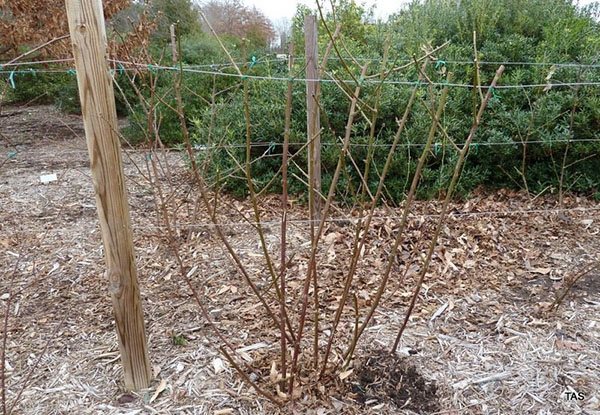

Autumn and spring pruning has different goals. In the fall, the bush is formed and prepared for winter.In the spring, the berry must be examined to check how it got over the winter. Only dead frozen branches will need to be removed. They are easy to distinguish from healthy ones in appearance. Such shoots become brittle, dry, black in color. Healthy twigs are covered with shiny brown bark and are flexible and resilient. If the gardener decides to neglect autumn pruning, this is fraught with the following consequences:
- The quality of the berries will decrease, they will become small and tasteless.
- The plant will weaken and be susceptible to various diseases.
- During the winter, the taste can freeze, because it is problematic to properly cover an overgrown berry.
Spring pruning can be considered sanitary. If the branches are damaged by rodents during the winter, it is also better to remove them.
Tools
To prune branches in the garden, you will need the following tools:
- The main tool you need is a secateurs. It makes smooth cuts easy and efficient. There are 2 types of secateurs on sale: chopping and cutting. The pruning shear has a curved shape and works like a scissor. The cutting pruner is equipped with straight blades that abut against each other during cutting.
- Loppers are used for hard-to-reach areas... These are the same secateurs, but with longer handles. And if an ordinary pruner cuts branches up to 2 cm in diameter, then the loppers are able to cope with twice that thickness.
- It is convenient to use special garden saws to remove branches and dry branches.
- In more subtle work, the use of garden knives is practiced. You can do the same manipulations with them as with secateurs, but you need to apply more force.


Choice of dressings
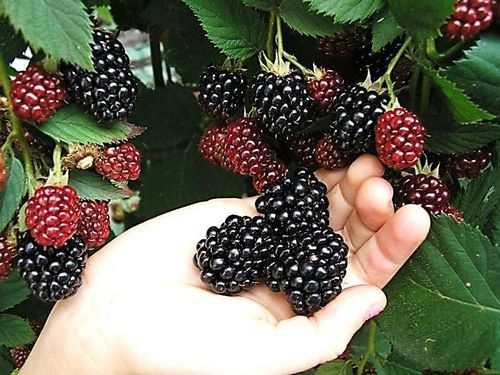

Top dressing is divided into two main types: mineral and organic. Mineral minerals are presented on the market in the form of complex and one-component. Mineral compositions are applied on average no more than 3 times per season, organic matter is used more often. Experts admit the simultaneous use of mineral and organic dressings. It is important to ensure that the soil is not oversaturated with nutrients.
Top dressing with mineral compounds
The active growth of green mass and the taste properties of berries are greatly influenced by nitrogen, potassium and phosphorus. In combination with trace elements, they form the basis for the balanced development of plants.
Mineral fertilizers are applied in pure form or in complex formulations. In the spring, at the stage of forming bushes, plants need nitrogen. Therefore, feeding is carried out with compositions with its increased content.
Potassium and phosphorus are more required during the fruiting period. The taste of fruits and their size directly depend on the volume of potassium.
The soil is enriched with nitrogen when introduced into the soil:
- sodium nitrate;
- calcium nitrate;
- ammonium sulfate;
- urea (urea);
- ammonium hydroxide.
The potassium content can be increased by introducing:
- potassium chloride;
- potassium sulfate;
- potassium salt;
- potassium nitrate;
Phosphorus is added as superphosphate or double superphosphate.
Novice gardeners are advised to use complex formulations. They contain all the necessary elements.
- Master. Universal feeding. Suitable not only for blackberries, but also for all plants. Promotes active plant growth. Applied by sprinkling or drip irrigation.
- Plantafol. It is used for foliar dressing. In the composition of nitrogen, potassium, phosphorus and other trace elements. Promotes the stimulation of physiological processes at various stages of plant growth.
- Kemira, Universal 2. Chlorine-free fertilizer, produced in the form of granules. Used for planting and during fruiting. Helps to increase the productivity of plants.
- Solutepass. Chlorine-free nitrogen fertilizer. Increases plant resistance to temperature extremes, drought, fungal diseases. It is used during the ripening period of the fruit.
- Agrifes. Anti-stress plant adaptogen. Promotes growth and frost protection.Strengthens local immunity to diseases and pests.
In the northern regions, blackberries require more careful maintenance. Therefore, feeding is done more often.
Top dressing with organic fertilizers
Organic fertilizers are better suited for feeding plants in the fall. They can be dry or liquid. If the fertilizer is dry - manure or chicken droppings, then they are embedded in the ground, where the plants have not yet been planted. In cases where the bushes have already been planted in a permanent place, organic matter is introduced by the root method during watering.
Important! Fresh organic matter is not used for feeding. Manure or droppings must first be re-cooked. Fresh fertilizer burns the plant roots.
Of organic fertilizers, the following have proven themselves best:
- mullein;
- bird droppings;
- urea;
- compost;
- wood shavings and ash;
- humus.
Most organic fertilizers are recommended to be diluted with water. Mullein is bred in a ratio of 1: 4. For poultry droppings, the ratio is 1: 1.
Organic fertilizers are also sold in specialty stores.
- Fertimix Biohumus. The drug promotes the growth of the root system and the growth of green mass of plants.
- Novofert Yagoda. During the flowering period, the drug is recommended to be applied every two weeks. Top dressing helps to increase immunity to pests and diseases. Accelerates fruiting. The duration of feeding is determined by the period of fruit ripening.
- Bioterra. The composition contains four types of manure. Convenient shape and ease of use have determined high popularity. The composition is versatile in use.
- Riverm. Top dressing is supplied in liquid form. Regular use contributes to the growth of green mass in the shoots and the formation of immunity to common diseases.
Regular use of organic matter can improve the structure of the soil, increase its fertility. Litter restores the level of calcium, potassium and nitrogen in the ground. Dry and liquid manure increases the water-holding capacity of the soil, making it looser.
Traditional methods
In addition to mineral and organic compounds, folk methods of fertilizing blackberries have shown high efficiency. For recipes, foods rich in micronutrients are used.
- Infusion of nettle. For cooking, use 2 kg of fresh grass. It is poured with water in a large barrel and left to wander in the sun for a couple of days. The concentrated mixture is diluted with water and used for irrigation. Nettle is most effective during the period of flowering plants and fruit ovary.
- Eggshell. The shells are collected only from raw eggs. It is dried, crushed and filled with water. The infusion is left for a day in a dark place. The finished product is used for watering the root circles. The shell saturates the soil with calcium and promotes active growth.
- Animal wool. Animal wool is used as an autumn feeding. It is buried in the ground during the digging of the earth. Raw materials are taken at the rate of 6 kilograms per 1 square meter.
- Yeast. To prepare the solution, use 10 grams of live yeast. They are bred in 10 liters of warm water. Add 2 tablespoons of sugar to the mixture and leave to ferment for 2 hours. After that, the solution is used for watering.
River and seaweed, compost from agricultural and food waste, fallen leaves, weeds, sawdust have shown high efficiency in feeding blackberries.
Dependence of the choice of fertilizers on the type of soil
The choice of fertilizers directly depends on the type of soil and its composition. For blackberries, areas with loamy soils are most suitable. The medium is neutral or slightly acidic. It is important that the soil is loose and retains moisture well.
If the site is sandy, it is recommended to add mullein or other organic fertilizers that increase water-holding properties before planting.
If there is limestone or clay on the site, it is recommended to dig up the site with a mullein before planting seedlings.The earth also needs to be enriched with magnesium and iron.
It is optimal to grow blackberries on black soil. To obtain a high yield, a carbonate layer is made on the site. It is buried 1.2 meters.
How to choose a tool?
Adult branches have a diameter of one and a half centimeters. Any secateurs can cut this thickness. To process a blackberry bush, it is better to choose a bypass tool, the principle of which is similar to the principle of scissors. When purchasing, it is worth carefully examining the gaps between the blades. If there is a gap, the product will "chew" on the branches of the plant.


Consider a few more recommendations from experienced gardeners.


It is rather difficult to name the specific dates for processing blackberries in the autumn period, but the brightest signal for the beginning of the process is the end of the fruiting of the plant. If the crop stops bearing fruit in August, you can start pruning the shrubs in that month. But most gardeners start pruning in September or late October. This allows them to carry out high-quality care, get rid of all unnecessary things and calmly wait for the winter cold.
It is important to remember that the gardener must have time to process the plant for the winter three to four weeks before freezing temperatures come, as the blackberries should be protected from the impending frost. You must not be late, otherwise the culture may freeze and die.
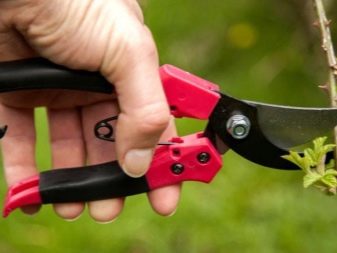

Features of feeding after the procedure
Caring for a plant is not only timely pruning, but also the introduction of the necessary fertilizers that will help the blackberry to recover and survive the winter. Most gardeners use organic matter for this, since such fertilizers are cheaper and more affordable. For example, rotted manure is an excellent option. You can also use the help of mineral fertilizers, which are most often applied when the soil is being dug.
To make organic matter more effective and make the plant's immunity stronger, its introduction in most cases is combined with mineral complexes. Consider the step-by-step process of feeding a crop.
- A layer of manure should be spread between the rows. The layer thickness is 5-10 centimeters.
- Sprinkle the required amount of fertilizer on top.
- The soil between the rows is carefully dug up so that the top dressing is well absorbed into the soil and reaches the roots.
- The most effective and demanded mineral fertilizer for autumn feeding is a mixture of superphosphate and potassium sulfate. Top dressing should be done annually.
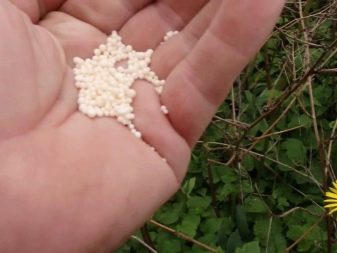

If you do not add substances necessary for the normal development of the plant to the soil, blackberries can freeze or be attacked by various pests or diseases.
After the end of winter, it is necessary to open the bush and see which areas are better preserved. You should wait a while and evaluate the appearance of the branches. Healthy ones will become more elastic, shiny and brown. The dead wood will be black, loose and incredibly fragile, it is necessary to get rid of it in a timely manner. If the frost has not touched six or four branches, this is great, but if less than three, the yield will be low, but the fruits will appear large and attractive.
Do not be afraid to prune anything extra, because if the plant is healthy, it has tremendous growth power. Thickening is more harmful to the culture, which appears due to insufficient elimination of excess branches. If you carry out the pruning process correctly, the yield will be significantly higher. It is important to keep an eye on the bushes, in which case they will repay the gardener with tasty and juicy black fruits.
For information on how to prepare blackberries for winter, see the next video.

